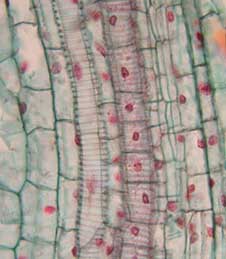2. STEM APICAL MERISTEM
This is a picture of Coleus. It is a common houseplant. The leaves are oppositely arranged. The nodes are the parts of the stem from which leaves and branches arise.
Here is a longitudinal section through a Coleus stem apical meristem. This region at the tip (apex) of the stem gives rise to cells of the stem. Observe several layers of tunica toward the outside surface of the apex (tunica = outer layers of cells dividing in a plane perpendicular to the meristem surface). The inner region which divides in many planes is the corpus (the body of cells beneath the tunica). This stem apical meristem is said to have a tunica-corpus organization. It occurs in many angiosperms.
In this picture you can see the apical meristem.
Cell divisions in the apical meristem give rise to the three primary meristems:
– protoderm (a single cell layer which is the “skin” of hte primary part of the plant)
– procambium (which gives rise to the primary vascular tissues and later to cells of the vascular cambium)
– ground meristem (which gives rise to the ground tissue system)
This is another longitudinal section through the shoot of Coleus. You can see the nodes of the stem from which leaves arise. At the axils of the leaves you can see bumps (AB). These are primordia which will ultimately give rise to branches. They are structurally similar to those at the stem tip.
In the stem just below the apex are 3 primary meristem: protoderm, procambium (seen as dark strands running toward the apex and into the leaves), and ground meristem (GM). At intervals below the apical meristem (AM) are found the young leaf primordia (LP), with their well-developed uniseriate and glandular trichomes. Look in the axils of the developing leaves for the branch or flower primordia, each with its own apical meristem with tunica-corpus and small leaf primordia. (See Raven 7th, p. 548, Fig. 25-2; 8th, p. 580, Fig. 25-2).
The primary meristems are very important. They give rise to the primary structure of the plant. The protoderm gives rise to the epidermis of the plant.
In the leaves and stem below the apex are the helical to scalariform vessels and tracheids of the xylem. Just outside these are the young sieve tubes and companion cells of the phloem. These primary vascular tissues are derived from the procambium. In the picture below you can see differentiating procambium. It will develop into tracheary elements; note the secondary wall thickenings. You can tell that it is not yet functional because there are still nuclei present in the cells (remember that these elements are dead at functional maturity).
The third primary meristem, the ground meristem, gives rise to all of the other primary tissues of the plant. This includes the cells of the cortex and pith; in other words everything other than epidermis and vascular tissues.
2. STEM APICAL MERISTEM





